Bank and Monument stations
Bank and Monument are interlinked London Underground and Docklands Light Railway stations that form a public transport complex spanning the length of King William Street in the City of London. Bank station, named after the Bank of England, opened in 1900 at Bank junction and is served by the Central, Northern and Waterloo & City lines,[10] and the DLR. Monument station, named after the Monument to the Great Fire of London, opened in 1884 and is served by the District and Circle lines. The stations have been linked as an interchange since 1933.[10]
| Bank and Monument | |
|---|---|
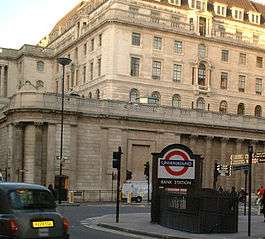 Entrance at the Bank of England, by Bank junction | |
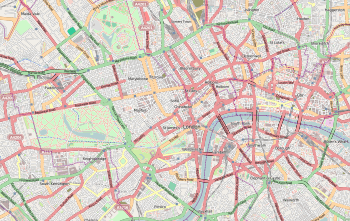 Bank and Monument Location of Bank and Monument in Central London | |
| Location | King William Street |
| Local authority | City of London |
| Managed by | London Underground |
| Number of platforms | 10 |
| Accessible | Yes (DLR only)[1] |
| Fare zone | 1 |
| OSI | Bank: Monument: [2] |
| London Underground annual entry and exit | |
| 2014 | |
| 2015 | |
| 2016 | |
| 2017 | |
| 2018 | |
| DLR annual boardings and alightings | |
| 2012 | |
| 2013 | |
| 2014 | |
| 2015 | |
| 2016 | |
| Key dates | |
| 6 October 1884 | Opened (MICCR) |
| 8 August 1898 | Opened (W&CR) |
| 25 February 1900 | Opened (C&SLR) |
| 30 July 1900 | Opened (CLR) |
| 18 September 1933 | Bank-Monument escalator link opened |
| 29 July 1991 | Opened (DLR) |
| Listed status | |
| Listed feature | Entrance within Bank of England & Redundant entrance within St Mary Woolnoth |
| Listing grade | I |
| Entry number | 1079134 (Bank)[8] 1064620 (Church)[9] |
| Added to list | 4 January 1950 |
| Other information | |
| External links | |
| WGS84 | 51.513°N 0.088°W |
The station complex is one of the busiest on the London Underground network, with usage of the station rising by 38% since 2008.[11] Owing to this, the station complex has been rated the Underground's worst station in passenger surveys,[12] and is currently undergoing a substantial upgrade and expansion.[11] The stations are in fare zone 1.
History
The Bank–Monument station complex was created by building links between several nearby stations constructed by different companies. The first station was opened by the Metropolitan Inner Circle Completion Railway.
Metropolitan Inner Circle Completion Railway, 1884
_p054_-_Monument_(map).jpg)
The Metropolitan Railway (MR) and District Railway (DR) had, by 1876, built most of the Inner Circle (now the Circle line), reaching Aldgate and Mansion House respectively. The companies were in dispute over the completion of the route as the DR was struggling financially and the MR was concerned that completion would affect its revenues through increased competition from the DR in the City area. City financiers keen to see the line completed established the Metropolitan Inner Circle Completion Railway in 1874 to link Mansion House to Aldgate. Forced into action, the MR bought out the company and with the DR began construction of the final section of the Inner Circle in 1879. The new section of railway included two new stations: Tower of London and another located close to the Monument.
The station at Monument opened with the name "Eastcheap" on 6 October 1884, after the nearby street, and was renamed "The Monument" on 1 November 1884.[10] Initially, trains from both companies served the station on the Inner Circle service but other operational patterns have been used. The Inner Circle service achieved a separate identity as the Circle line in 1949 although its trains were still provided by the District or Metropolitan lines.[10]
Waterloo & City Railway, 1898
The Waterloo & City Railway was built by the London and South Western Railway (L&SWR) to link its terminus at Waterloo to the City. The station, with platforms under Queen Victoria Street and close to Mansion House, opened on 8 August 1898 as "City".[10]
The Waterloo and City line platforms were renamed "Bank" on 28 October 1940.[10] In September 1960, the steeply sloping passages to the platforms were supplemented with the "Travolator", one of the few sets of moving walkways on the whole underground system.[13] Advertising at the Waterloo & City station often takes the form of large painted murals on the walls and ceilings of the sloped exits, forming one of the largest advertisements on the underground.
As the W&CR was owned by the L&SWR, a mainline railway, it became part of British Rail, only being transferred to Underground operation in 1994, becoming the Waterloo & City line.
City & South London Railway, 1900
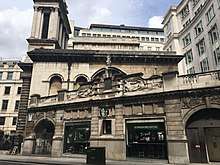
The first station to be known as Bank opened on 25 February 1900 when the City & South London Railway (C&SLR, now part of the Northern line) opened its extension from Borough to Moorgate.[10] The earlier terminus of the line, King William Street, on a different tunnel alignment was closed at the same time.
The C&SLR had obtained permission to demolish the 18th-century church of St Mary Woolnoth on the corner of Lombard Street and build a station (originally proposed to be named "Lombard Street") on the site. After public protest, the company changed its plans to build only a sub-surface ticket hall and lift entrance in the crypt of the church. This necessitated moving the bodies elsewhere, strengthening the crypt with a steel framework and underpinning the church's foundations. Unusually for stations later converted to escalators, the original lift access from the ticket hall is still in use.
Central London Railway, 1900
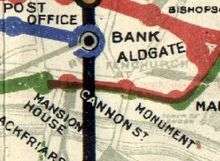
The opening of the eastern terminus of the Central London Railway (CLR, now the Central line) at Bank followed on 30 July 1900.[10]
As with the C&SLR, the high cost of property in the City, coupled with the presence of the Royal Exchange, the Bank of England, and Mansion House, meant that the station had to be built entirely underground. Permission was granted by the City of London Corporation for the station to be sited beneath the busy junction of roads meeting at this point on condition that public subways were provided to act as pedestrian road crossings. To avoid undermining the road above, the station's lifts were installed in separate lift shafts rather than paired two-per-shaft as usual.
To avoid wayleave payments to property owners and to lessen possible claims for damage during construction and operation, the CLR tunnels were directly under public streets. This caused the platforms under Threadneedle Street and Poultry to be so curved that one end of the platform cannot be seen from the other. East of Bank station the Central line tunnels have sharp curves to avoid the vaults of the Bank of England itself. Due to the close proximity of the CLR, W&CR and C&SLR stations, and the non-competing directions of their services, their ticket halls were soon connected, but connection between the CLR and C&SLR platforms were made only when escalators were installed in 1924. The Central London Railway station itself was reconstructed during the major rebuilding of the Bank of England in 1925. The booking hall underneath Bank junction was redecorated and a new subway entrance built into the corner of the Bank itself.[14]
Monument link, 1933
The southern end of the C&SLR (by then part of the Edgware-Highgate-Morden line) platforms was close to those of Monument station and, on 18 September 1933, a connecting escalator link was opened, connecting the two stations directly for the first time.[10][13]
Docklands Light Railway and station refurbishment, 1990s
In 1991, the Docklands Light Railway was extended to Bank Station, following criticism of the original, poorly connected terminus at Tower Gateway.[15] The new platforms were built parallel to but deeper than those of the Northern Line, with connections at one end to the Central line and Monument Station at the other. As part of the construction of the extension, a new link between the Waterloo & City and the Central line was excavated – uncovering part of one of the Greathead tunnelling shields used for the Waterloo and City line. This shield forms part of the new passageway, and passengers pass through when transferring between the two lines.[16] As with all other DLR stations, the DLR platforms are accessible, however the route is indirect with the use of three different passenger lifts required to reach the DLR.[14]
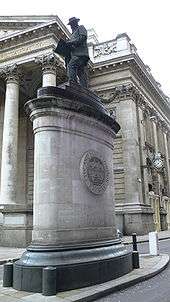
In January 1994, a statue of James Henry Greathead was erected outside the station, next to the Royal Exchange. It was unveiled by the Lord Mayor of London and is positioned on a plinth which hides a ventilation shaft for the Underground.[17]
.jpg)
The rest of the station was comprehensively refurbished, with decorative tiling panels based on the City’s coat of arms, new lighting and replacement of escalators. This work was completed in 1997, partially funded by the City of London Corporation.[18]
New Bloomberg entrance, 2010s
In the late 2010s, a new entrance was constructed at Bloomberg's new London headquarters on Walbrook, near Cannon Street station,[19] providing direct access to the Waterloo & City line via four new escalators and two lifts – providing step free access for the first time. First announced in 2008,[20] construction began in November 2015,[21] and the new entrance was opened on 30 November 2018. The new entrance was officially opened by Mayor of London Sadiq Khan and former Mayor of New York Michael Bloomberg in December 2018.[22]
The new entrance incorporates etched glass panels by artist John Hutton, depicting 66 figures based on the ancient Roman history of the area, including the Roman Temple of Mithras. The artwork was originally completed in 1962 on Bucklersbury House, the post war office building previously located on the site.[23][24]
Future station upgrade and expansion
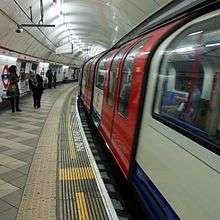
Since 2003, demand at the Bank-Monument station complex has risen by over 50% to 337,000 customers per day.[14] According to Transport for London, "areas of the station are close to ‘saturation’ point, where day to day demand overwhelms capacity". Unlike other congested stations such as Oxford Circus, passengers cannot be held back at station entrances during peak times to avoid overwhelming the station, as around 50 percent of passengers are interchanging between lines.[11] The high demand on the station is exacerbated by the narrow passageways, pinch points, spiral staircases and indirect routes between lines. Some parts of the station operate "one way", with staff directing passengers on longer routes to increase the capacity of the station.[14] Given these issues, the station complex is currently under construction to substantially upgrade and increase station capacity by 40%, at a cost of around £620m.[11][25] The overall project – incorporating twelve new escalators, two new lifts and two moving walkways – includes:[26]
- A new southbound platform for the Northern line and conversion of the existing southbound platform to passenger circulation space.
- New direct passenger tunnel with moving walkways connecting the Northern line and Central line.
- New escalators between the Northern line and Docklands Light Railway (DLR).
- A new station entrance and ticket hall on Cannon Street, with new escalators and step free access to the Northern line and DLR.
- Modernising the station to comply with contemporary fire and evacuation standards.
Following consultations in the early 2010s[27][28] and a Transport and Works Act Order in 2015,[29] construction began in April 2016, and is estimated to take 6 years. By July 2019, the project had reached the halfway stage.[30]
Owing to the severe curvature of the Central line platforms, the resulting gap between the train and the platform is substantial. As a result of this, no step-free access is currently proposed for the Central line, as the cost would be prohibitive and difficult for passengers to use.[31]
The new Northern line tunnel is being dug from a worksite on King William Street, using the underground spaces leftover from the closed King William Street tube station.[32][33] Using the old running tunnels as circulation space has previously been used at Angel and London Bridge stations. Before the project can be completed, the Northern line Bank branch will have to close for several months to allow the existing line to be connected to the new running tunnels. As of April 2020, this closure will occur in spring/summer 2021.[11]
Ticket halls and entrances
Following the opening of the Bloomberg entrance in 2018, the station complex has fifteen entrances and four ticket halls.[14][34]
- Bullring (Central Line) ticket hall, located underneath Bank Junction.
- Lombard Street (Northern Line) ticket hall, under Lombard Street.
- Monument ticket hall, located under Monument Street adjacent to the Monument to the Great Fire of London, serving the District & Circle Lines.
- Walbrook ticket hall, at Bloomberg London, serving the Waterloo & City line.[22]
Notable events
On 11 January 1941, during the Blitz, 56 people were killed and 69 were seriously injured when a German bomb hit the booking hall, with the blast travelling down the stairs and escalators to the platforms. The crater, measuring 120 by 100 feet (37 m × 30 m), was covered with a Bailey bridge for the traffic to pass over. The station itself was closed for two months.[35][36]
On 7 September 2003, Bank station was used for a disaster training exercise, Exercise Osiris, billed as "the most realistic live disaster exercise of its kind". The event, lasting several hours and involving about 500 police, fire brigade, ambulance and London Underground personnel, was intended to prepare the emergency services for mass decontamination in the event of a chemical, biological, radiological or nuclear attack.[37]
Connections
London Buses routes 8, 11, 15, 17, 21, 25, 26, 35, 43, 47, 133, 141, 149, 344, 388, 521 and night routes N8, N11, N15, N21, N25, N26, N133, N199, N242, N550 and N551 serve the station complex.[38][39][40]
References
- "Step free Tube Guide" (PDF). Transport for London. May 2020. Archived (PDF) from the original on 7 August 2020.
- "Out of Station Interchanges" (XLS). Transport for London. 19 February 2019.
- "Multi-year station entry-and-exit figures (2007-2017)" (XLSX). London Underground station passenger usage data. Transport for London. January 2018. Retrieved 22 July 2018.
- "Station Usage Data" (CSV). Usage Statistics for London Stations, 2018. Transport for London. 21 August 2019. Retrieved 27 April 2020.
- Transport for London (12 February 2013). "Freedom of Information DLR usage 1213". Transport for London. Retrieved 10 November 2013.
- "Up-to-date DLR entry/exit statistics for each station" (XLSX). What Do They Know. Transport for London. 18 March 2016. Retrieved 2 April 2016.
- "Passenger Numbers - Docklands Light Railway Limited" (XLSX (after downloading zip)). What Do They Know. Transport for London. 8 June 2017. Retrieved 11 September 2017.
- Historic England. "Bank of England (1079134)". National Heritage List for England. Retrieved 3 April 2015.
- Historic England. "Church Of St Mary Woolnoth (1064620)". National Heritage List for England. Retrieved 3 April 2015.
- Rose, Douglas (1999). The London Underground, A Diagrammatic History. Douglas Rose/Capital Transport. ISBN 1-85414-219-4.
- "Improvements and Projects – Bank & Monument". Transport for London. Retrieved 12 April 2020.
- "Bank is 'most disliked' Tube station". BBC News. 23 April 2013. Retrieved 12 April 2020.
- "Research Guide No 38: Bank Station" (PDF). TfL Corporate Archives. 5 January 2017. Retrieved 12 April 2020.
- "Transport and Works Act 1992 – London Underground (Bank Station Capacity Upgrade) Order – Design and Access Statement part 1" (PDF). Transport for London. September 2014. Retrieved 12 April 2020.
- "London Docklands Railway (City Extension) Bill (By Order) (Hansard, 6 March 1986)". api.parliament.uk. Retrieved 12 April 2020.
- "Greathead shield at Bank". London Remembers. Retrieved 12 April 2020.
- "James Greathead statue". London Remembers. Retrieved 12 April 2020.
- "Bank Station modernisation plaque". London Remembers. Retrieved 12 April 2020.
- "Bank Station Part 1: The Forgotten Upgrade". London Reconnections. August 2012.
- "Transport for London strikes a bargain basement deal". Transport for London. 29 February 2008. Retrieved 29 May 2020.
- "Bank station: work starts on a new entrance". Transport for London. 5 November 2015. Retrieved 12 April 2020.
- "New Waterloo & City line entrance relieves congestion at Bank station". Transport for London. 12 December 2018. Retrieved 12 April 2020.
- "Bucklersbury House, City of London". recclesia.com. Retrieved 12 April 2020.
- "London Underground displays the Hutton Panels inside Bank station". www.ianvisits.co.uk. Retrieved 12 April 2020.
- Smale, Katherine (29 January 2019). "TfL considers 'expensive' Bank station redesign". New Civil Engineer. Retrieved 12 April 2020.
- Marshall, Geoff (4 June 2018). "Inside the NEW Bank Tube Station". YouTube. Retrieved 12 April 2020.
- "Major new scheme proposed to ease congestion at Bank station". Transport for London. 20 December 2010. Retrieved 12 April 2020.
- "Exhibition and consultation on Bank Stn upgrade plans". Transport for London. 27 May 2014. Retrieved 12 April 2020.
- "Major upgrade of Bank Tube station gets the green light for work to begin". Transport for London. 18 December 2015. Retrieved 12 April 2020.
- "Bank station upgrade construction reaches half-way stage". Transport for London. 1 July 2019. Retrieved 12 April 2020.
- Khan, Sadiq (12 February 2020). "Bank Central Line Step Free". Mayor's Question Time. Retrieved 12 April 2020.
- "Bank station upgrade construction reaches half-way stage". Transport for London. 1 July 2019. Retrieved 12 April 2020.
- "Behind the scenes at London Underground's Bank tube station upgrade". www.ianvisits.co.uk. Retrieved 12 April 2020.
- "3D maps of every Underground station". www.ianvisits.co.uk. Retrieved 12 April 2020.
- "The Underground at War". www.nickcooper.org.uk. Retrieved 12 April 2020.
- "Bank Tube Station Blitz". Imperial War Museums. Retrieved 12 April 2020.
- "London undergoes terror test". BBC News. September 2003. Retrieved 26 July 2013.
- "Buses from Bank" (PDF). TfL. 30 November 2019. Retrieved 31 May 2020.
- "Buses from Monument and Cannon Street" (PDF). TfL. 30 November 2019. Retrieved 31 May 2020.
- "Night buses from City of London" (PDF). TfL. 30 November 2019. Retrieved 31 May 2020.
External links
| Wikimedia Commons has media related to Bank and Monument stations. |
- A diagram of the Bank/Monument station complex
- Another diagram (in colour)
- Bank Station from the Open Guide to London
- History of Bank station, including a picture just after the 1941 bomb
- London Transport Museum Photographic Archive
- C&SLR Lombard Street entrance in front of St Mary Woolnoth, 1914
- C&SLR King William Street entrance in front of St Mary Woolnoth, 1914
- Entrances in front of Royal Exchange, 1914
- Entrance in front of Royal Exchange, 1923
- Ticket hall showing steel support structure and tops of escalators, 1925
- Ticket hall, 1933
- View of bomb crater, January 1941
- More photographs of Bank station
- Photograph and Street View imagery of Monument station
| Bank | ||||
| Preceding station | Following station | |||
|---|---|---|---|---|
| Central line | ||||
| Northern line City Branch | towards Morden |
|||
Terminus | Waterloo & City line Mondays to Saturdays only | Terminus | ||
| Preceding station | Following station | |||
| Terminus | Docklands Light Railway | |||
| Monument | ||||
| Preceding station | Following station | |||
| Circle line | ||||
| District line | towards Upminster |
|||
| Former services | ||||
| Preceding station | Following station | |||
| District line (1884–1967) | towards Upminster |
|||